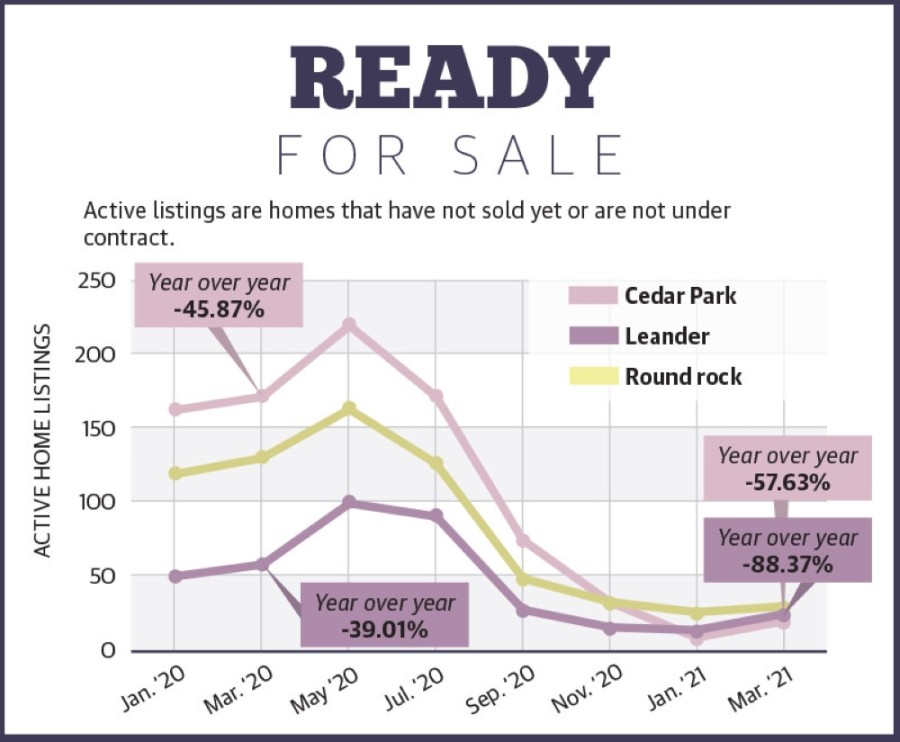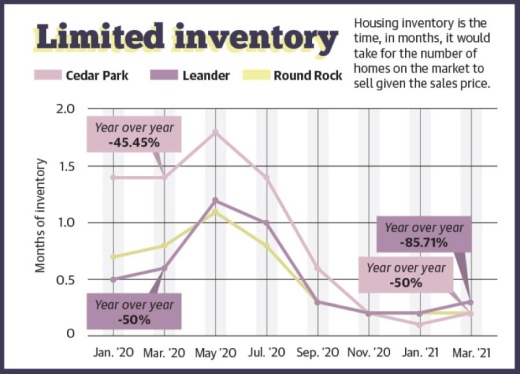Chen, who moved from Chicago, said he had heard that Austin and Texas in general was more affordable than the Midwest, adding that he was surprised when he was constantly outbid by other homebuyers far beyond what he could afford.
He said he was looking for a 3,500-square-foot home for about $600,000 and ended up purchasing a 3,100-square-foot home for $780,000.
“And it was not top-of-the-line schools,” which Chen said was one of his priorities. “People were saying Texas, Austin [and] in that area, prices were quite affordable. That was not the case.”
The Central Texas housing market has seen a record-breaking year despite the coronavirus pandemic. Most notably is the lack of inventory, which has in turn inflated prices as homes sell faster than ever.
A healthy real estate market in Leander-Cedar Park area would have between 500 and 600 single-family homes for sale at any given time. In early April, there were about 55, said Paul Cutler, owner of Exit Realty Cedar Park.
Monthly housing inventory indicates how long a home takes to sell by dividing the number of active listings by the average number of home sales per month over 12 months, according to the Real Estate Center at Texas A&M University. If inventory levels are around 6.5 months, there is a balanced housing market.
Days on market is also an important indicator because it tells the average number of days homes are listed on the local real estate server over a month and therefore how desirable homes are in the area.
“Buying a home should be one of the most exciting things in the world, but it’s placing quite a lot of stress on buyers at the moment,” Cutler said. “A lot of the fun has been taken out for buyers at the moment.”
In March 2020, Leander homes spent an average of 63 days on the market, and Cedar Park homes spent an average of 13 days on the market, according to an Austin Board of Realtors report.

The days on market for Leander dropped to 14 in March 2021, down 77.78%, and to five in Cedar Park, down 61.54%.
Comparatively, Round Rock went from 28 days on the market in March 2020 to seven in March 2021.
Cutler added that another factor impacting inventory is homeowners’ reluctance to move during the pandemic, which kept them in their homes longer than they previously would have and resulted in fewer homes on the market.
“It’s simply that the demand for Austin and surrounding areas is still so great,” Cutler said.
Rising prices
With low supply and high demand, median home prices continue to climb, exacerbated by the competition for homes, Leander-Cedar Park real estate agent Kristin Hepp said.
Then, first-time homebuyers are looking to enter the market due to the low interest rate, adding to the competition, she said.
The median sale price of a Leander home in March 2020 was $287,047, according to ABoR data. In March 2021, it increased 47.54% to $423,495.
The same trend was seen in Cedar Park where the sale price of a home in March 2020 was $359,500. In March 2021, it increased 36.02% to $489,000.
In Round Rock, the median sale price of a home in March 2020 was $292,455 and rose to $425,000 in March 2021.
Since homes are selling at prices higher than listed, the values of neighboring homes are also increasing, Hepp said.
For example, if a home listed at $300,000 sells for $350,000, a neighbor selling their home could start their listing at $350,000 and potentially sell it for more, further inflating prices, she said.
Hepp said every home she has sold in the Leander-Cedar Park area over the past six months has been a multiple-offer situation.
When homes are under multiple offers, it becomes a bidding war where the home is nearly guaranteed to sell above the list price, Hepp said.
But with inventory so low, she said homes are frequently selling $100,000-$250,000 above the list price and often in cash, as lenders are not willing to provide more money than the home’s original list price.
“It’s not just happening at a $200,000 price point; it’s happening at price points across the range,” Hepp said.
Cutler said he, too, is seeing buyers willing to pay in excess of the home’s list price, causing first-time homebuyers to have to look further away from Austin in order to find a home they can afford.
“I have a saying that ‘A home is worth what someone is prepared to pay for it,’ and we are seeing people prepared to pay well in excess of what they’re on the market for because that’s what it’s worth to them,” Cutler said.
Other factors in the rising home prices are the increased cost of lumber and a labor shortage to build new homes, delaying home starts, area real estate agents said.
Joshua Roberson, a senior data analyst for the Real Estate Center at Texas A&M University, said the Central Texas market was already having issues keeping up with demand prior to the pandemic, particularly with new construction as it continued to recover from the Great Recession of 2007-09.
“[New construction] never really fully recovered in terms of producing,” he said. “They’re just not going to be able to keep up with this new wave of demand. Even though permits are up, it’s just not going to be able to fill the gap.”
Williamson County Judge Bill Gravell told Community Impact Newspaper even in his driving around the county, he sees lots without homes already displaying “sold” signs.
Particularly in Jarrell, just north of Georgetown, Gravell said he saw a new subdivision with at least 200 lots each with a “sold” sign while only maybe 20-30 homes were framed up.
“I just thought this is so bizarre,” Gravell said. “The collision of the pandemic, of major industry development, tech hub and the hottest housing market, the roaring ’20s are alive.”
For the homes that are going on the market, they hardly stay for long, Roberson said.
Cutler said he has seen homes purchased without inspections. And due to them being purchased with all-cash offers, they closed in a week or two, far shorter than the average 30-50 days.
Hepp added that she now sees homes put on the market for a certain number of days and then the sellers take the highest and best offer from that period.
The entire Austin-Round Rock five-county metro area saw a record-low number of days on market, reporting 26 days in March 2021. This number was down from 54 days in March 2020, ABoR data shows.
Hepp made note that the trends of low inventory and increased prices are not only being seen in fast-growing places such as the Austin metro, but also all over the country.
“I know that it’s not an ideal market for buyers, but I don’t want to see buyers give up because we’re not forecasting a decrease in prices,” Hepp said. “The sooner that you can get in, the sooner you’re going to be able to build equity and wealth through the real estate market.”
 Potential bubble?
Potential bubble?While some may have memories of the housing market crash in 2008, Hepp and Roberson said what is happening in Central Texas is not the same thing.
During the housing market crash, individuals were purchasing homes at very low interest rates and qualifying for and receiving generous home loans they would likely not qualify for otherwise, leading homeowners to purchase bigger homes than they could afford and then were forced to foreclose or short sale.
Interest rates are again low due to the coronavirus pandemic, but homebuyers are fronting additional costs, not lenders, Hepp said.
Federal safeguards were also put in place following the crash to prevent another event from occurring, including the establishment of the Federal Housing Finance Agency, among others.
She added that while the large year-over-year jumps may slow down, homes will continue to appreciate and are still a worthy investment.
“The biggest difference between now and the [housing market crash] where we were in some type of a housing bubble is that now all the homeowners have equity in their home,” Hepp said. “Before, what happened was people got into houses that they couldn’t afford, using mortgage products that were not consumer-friendly, and they didn’t have equity.”
Cause of growth
Area real estate agents attribute much of the growth and therefore competition for homes to new businesses such as Apple and Tesla coming to the Austin metro.
They also said low unemployment is a factor as new industries have to bring in employees, who are then purchasing homes.
Cutler said most of his referrals are from out-of-state homebuyers.
As of April 13, the Austin-Round Rock area had a preliminary unemployment rate of 5.3% in March, compared to 12.2% in April 2020 at the start of the pandemic, according to the U.S. Bureau of Labor Statistics.
With this, area real estate agents said they do not see the market slowing down any time soon.
“We still have over 200 people moving to the Greater Austin area every day, and there is no way this is going to slow down anytime soon,” Cutler said.





